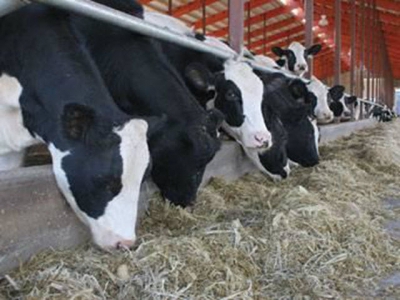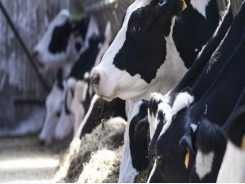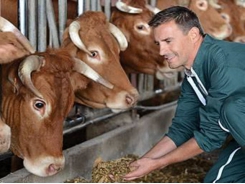Prepartum DCAD nutrition leads to enhanced transition cow success

Prince Agri Products | Proper DCAD implementation improves transition cow health, early lactation milk yield and, ultimately, producer profitability.
Transition cow health, early lactation milk yield and producer profitability improved through diet
Many strategies are implemented in transition cow programs in dairies across the United States with varying degrees of execution and subsequent success. Of these strategies, very few have the consistent impact on transition cow health and early lactation performance as prepartum negative dietary cation-anion difference (DCAD) balancing. When managed and fed correctly, this approach in prepartum dairy cow diets yields reliable success.
Numerous research trials have been conducted on prepartum negative DCAD diets with notable success, regardless of nutrition and management strategies, including one or two group dry cow programs, feeding high or low-energy diets, and across a range of feedstuffs. Proper implementation improves transition cow health, early lactation milk yield and, ultimately, producer profitability.
A prepartum negative DCAD diet significantly minimizes the occurrence of milk fever and subclinical hypocalcemia (SCH), defined as blood calcium below 8.5 mg/dL. Why is that important? Milk fever is a gateway disease. Calcium is not just integral to milk production, but also smooth muscle contraction and, therefore, is a key player in expulsion of the fetus and contraction of the uterus post-calving, teat closure after milking and rumen contraction. In other words, most cows afflicted with milk fever are more likely to succumb to other transition disorders, including retained placenta, metritis, mastitis, ketosis or displaced abomasum. These compounding disorders disadvantage the cow both in the first few weeks and throughout her entire lactation.
After calving, less than 5 percent of cows get clinical milk fever, as exhibited by cows being visibly down and needing immediate treatment. Subclinical hypocalcemia occurs in greater than 50 percent of the animals in a herd, but is often times not truly recognized because the cow may not show obvious signs. Unfortunately, the appearance of these cows may seem “normal” to most producers, nutritionists and veterinarians, if they are not paying close attention.
Greater economic impact
The economic impact of cows with SCH is far greater than those with clinical milk fever because they make up a larger percentage of the herd. Hypocalcemic cows are 5.4 times more likely to get mastitis, 4.0 times more likely to have a retained placenta, and cows with retained placentas are 5.7 times more likely to encounter metritis. Not only does the cost of milk fever and SCH become a financial burden on the dairy producer, the “gateway” costs of mastitis, retained placentas, metritis, displaced abomasum and ketosis can continue to exacerbate this financial burden. Estimated costs per case are shown in Table 1.
Studies have demonstrated that cows with proper calcium status at calving have a reduced incidence of not only milk fever and SCH but also metritis, retained placentas and uterine infections. Additionally, if adequate calcium status is achieved pre-calving, milk production is also improved.
These costs can be put into perspective by comparing dollars associated with multiple disease incidents when not using a negative DCAD balancing program versus feeding a -15 mEq/ 100 g of DM diet prepartum. Based on published data, and assuming a herd of 1,000 milking cows, with 45 percent of those being heifers, the difference in economic impact between the two strategies is calculated in Table 2.
From the example above, the dairy producer should save approximately $74,000 per 1,000 calvings when feeding a negative DCAD diet prepartum. This analysis can be extended by investigating just one of the other diseases listed above -- for example, metritis -- and the impact DCAD balancing has on profitability. To demonstrate the differences on a percentage basis of DCAD versus non-DCAD balanced diets prepartum, it is estimated that normocalcemic cows have a 15.8 percent risk of getting metritis versus 63.9 percent in hypocalcemic cows. Table 3 illustrates estimated cost savings associated with metritis by utilizing the data in Table 2.
The figures in Table 3 illustrate approximately $88,000 saved per 1,000 calvings, although it should be noted there are some overlapping dollars accounted for in the two examples (Table 2 and Table 3). Included in these calculations is an estimate of milk loss that occurs with fresh cow disease. However, the way these estimates are calculated, one cannot simply add the two values together to get total dollars lost from hypocalcemia and metritis.
Regardless of the overlap that may occur, it is evident that utilizing DCAD balancing in prepartum diets has an economic benefit for transition cows, not only for alleviation of milk fever and reduction of SCH, but also reduced downstream disorders that arise from poor calcium status.
Taking a proactive approach
Utilizing prepartum negative DCAD balancing is a proactive approach to managing calcium status and transition cow health. When trusted on farm advisers respond to challenges with educated approaches, the opportunity for herd advancement and improvement becomes unlimited. Feeding a negative DCAD diet is a preventative approach to help reduce hypocalcemia, which provides the producer opportunities to become more profitable.
Implementation of a prepartum negative DCAD feeding program is becoming increasingly important in driving profitability of a dairy. As dairies get better, there is less room for error to maintain herd health and production. Dietary cation-anion difference balancing of the diet is a “hands-off” approach to managing transition cow success to help promote improved herd health, productivity and profitability to the dairy operation.
Có thể bạn quan tâm
Phần mềm

Phối trộn thức ăn chăn nuôi

Pha dung dịch thủy canh

Định mức cho tôm ăn

Phối trộn phân bón NPK

Xác định tỷ lệ tôm sống

Chuyển đổi đơn vị phân bón

Xác định công suất sục khí

Chuyển đổi đơn vị tôm

Tính diện tích nhà kính

Tính thể tích ao hồ




 The high cost of metabolic diseases in dairy…
The high cost of metabolic diseases in dairy…  Analysis of fats in the ruminant diet
Analysis of fats in the ruminant diet